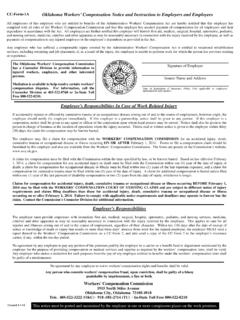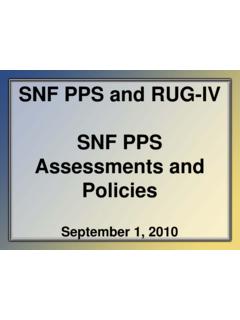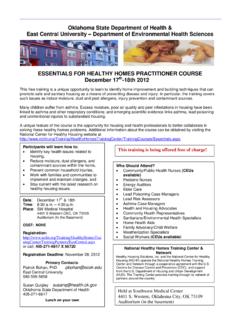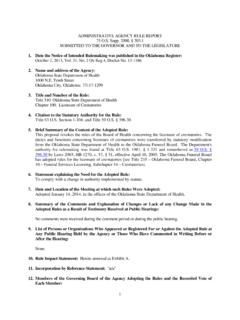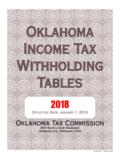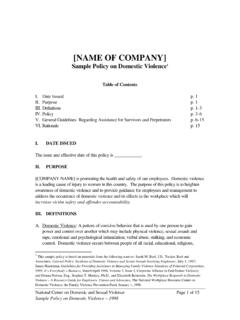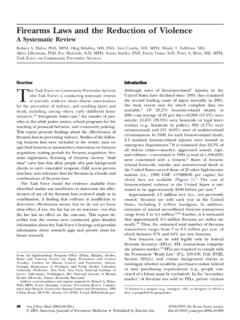Transcription of Domestic Violence Awareness Guide - Oklahoma
1 Domestic Violence Awareness GuideOklahoma Department of Human Services Family Support Services Division Table of Contents Acknowledgments 5 Foreword 6 Introduction 7 chapter 1 What is Domestic Violence ? 8 Power and Control Wheel 9 The Cycle of Violence 10 Equality Wheel 13 Signs of Domestic Violence 14 chapter 2 Who Are the Victims? 15 National Victim Statistics 15 Why Women Stay 15 The Progression of Domestic Violence 16 Barriers to Leaving a Violent Relationship 17 Victims Health Problems and Substance Abuse 18 Domestic Violence within Gay Relationships 19 Domestic Violence and the Elderly 19 Adolescent and Teen Dating Violence 20 Teen Power and Control Wheel 22 Safety Planning for Teens 23 Domestic Violence and the Effect on Children 243 chapter Who Are the Batterers? 30 Predictors of Domestic Violence 30 Warning Signs for the Batterer 31 Immediate Ways for Batterers to Stop Violence 31 Behavioral Tactics 32 Batterer Intervention 33 Recidivism 33 Couples Counseling and Mediation 33 Anger Management Programs 33 Batterers and Substance Abuse 342 chapter 4 What Can We Say and Do?
2 35 Intervention 36 Special Note for DHS Case Managers 38 TANF and Women in violent relationships 39 What if she decides to stay? 39 Interview Tips 40 Individuals Against Domestic Violence 41 Communities Against Domestic Violence 42 chapter 5 Assessing Danger, Safety Planning and Crisis Intervention 43 Assessing the Danger 43 Safety Planning to Prevent Escalation 43 Safety When Preparing to Leave 45 Personalized Safety Plan 46 Personal Safety When the Relationship is Over 48 Children s Safety Plan 49 Tips for Mothers 49 Workplace Guidelines 50Be Safe at the Courthouse 51 Flow Chart for Handling Crisis Calls 52 chapter 6 The Legal System 53 Using the Law to Help You 54 Information on the Victim Protective Order 55 State of Oklahoma Domestic Violence Law 58 chapter 7 Resources 60 OCADVSA 60 Latino Community Development Agency 60 Oklahoma Office of Attorney General 60 Address Confidentiality Program 61OK VINE Criminal Tracking System 61 OK Native American Domestic Violence Coalition 61 Oklahoma Domestic Violence Programs by City
3 62DV and Sexual Assault Programs by County 67 Legal Aid Services of Oklahoma , Inc. 70 Batterer s Intervention Services 723 DV Coalitions by State 74 National Domestic Violence Hotline 75 Related Web Sites 76 Community Resource Page 77 chapter 8 Taking Care of You 78 4 Acknowledgments We would like to thank the agencies, organizations, and individuals who contributed to the development of this training curriculum. Some contributed by allowing usto use information printed on their web sites, which are devoted to stopping Domestic Violence . Others contributed by graciously providing professional or personal expertise inthis area. Each contributor joins us in the effort to educate service providers and the community in general about Domestic Violence . Consultations provided by:Marcia Smith, Executive Director of the Oklahoma Coalition Against Domestic Violence and Sexual Assault Beth Stanford, Director of Education for the Oklahoma Coalition Against Domestic Violenceand Sexual Assault Ann Lowrance, Director of Domestic Violence and Sexual Assault Services with the OklahomaDepartment of Mental Health and Substance Abuse Services Pat Cole, Associate Director of the National Training Center on Domestic and Sexual Violence Elizabeth Haynie, Programs Field Representative for the Oklahoma Department of HumanServices Aging Services Division Kathy Simms, Programs Administrator for the Oklahoma Department of Human Services Children and Family Services Division, Child Protective Services Esther Rider-Salem.
4 Programs Manager II for the Oklahoma Department of Human Services Children and Family Services Division, Child Protective Services Contributing Agencies and Organizations:American Bar Association Domestic Violence Division Family Violence Prevention FundMetropolitan King County Council, WashingtonNational Coalition Against Domestic Violence and Sexual AssaultNational Committee for the Prevention of Elder Abuse Oklahoma Coalition Against Domestic Violence and Sexual AssaultOklahoma Department of Human Services Aging Services DivisionOklahoma Department of Mental Health, Substance Abuse Services, Domestic Violence andSexual Assault Compiled and Edited by:Nathan Durant, Programs Field Representative, OKDHS, FSSD-Training Section Rebecca Kephart, Programs Field Representative, OKDHS, FSSD-Training SectionCindy McGowan, Programs Field Representative, OKDHS, FSSD-Training Section 5 Foreword By Nathan Durant Recently I was asked to write an introduction to this Domestic Violence AwarenessGuide.
5 I immediately began to look at the statistics for the preceding year and some fromapproximately 10 years ago. They all said that we need to do something about the these were somebody else s numbers, and I didn t know who those people were. Maybesomeone else would address the was, however, one number that I couldn t get out of my mind. It kept comingback to haunt me. This number was close to home. You see, last summer I met a young couplewho very much wanted to get married. They couldn t seem to live without each other. Theyseemed to get along fairly well except for a couple of things. He had what they called a badtemper. She was willing to overlook it, thinking he would change. He also grew up in an abusive home, but thought that he had grown up now and would never act like his got married and almost immediately began to go from job to job.
6 There was alot of pressure to succeed. She was willing to do whatever it took. She quit her schoolingso they could move to another place where he could work. This was a place where heknew a few people, but she knew no one. Now isolated from family, friends, and evencasual acquaintances, things really started to change. The arguments began to happen on aregular basis. The level of stress continued to rise. She has no one to sit and talk with justto see if this is normal married life. They argued, and she said that suddenly he was on top of her with his hands around herthroat, choking her and saying, I ll kill you. Normal? I don t think so. She was not in a placewhere we could talk to each other and try to help her decide what to do. Remember that pressure she feels to succeed. I can only guess right now what she is thinking regarding what to m also wondering if there s a police officer where she lives who would respond appropriatelyto a Domestic Violence call at their home.
7 I ve wondered if there might be a social worker attheir DHS office or a crisis center counselor who has the understanding to help her talk throughthis and make good now I can t tell you how this will end. What I do know about statistics is that ifshe does get out of her situation, it will probably involve another person or several other peoplewho have taken the time to learn about Domestic Violence , the dynamics, and the results. Thisperson (or persons) will help her think through this situation that has all kinds of pressure tosucceed. I m hoping she succeeds. I think you are, are untold numbers of victims, just like the one I described, who come throughour offices as clients, live in our neighborhoods, go to our churches, and shop at the same storeswe do. These folks ask for help sometimes in subtle ways.
8 Maybe it s just that they come to ouroffice with a black eye wondering if we re going to ask about it. With all this considered, theresponsibility comes back to us to learn about Domestic Violence and be ready to help anytime we can. 6 Introduction Domestic Violence is a growing epidemic in this country. Our entire society isbeginning to feel its effects. In the past, Domestic Violence has been mislabeled as a family matter. Consequently, communities have played a minimal role in prevention and intervention. Today as a society, we are more informed. We now understand that batterers andvictims come from all races, genders, socioeconomic classes, ages, religious affiliationsand environmental backgrounds. Although we recognize that both abusers and victims may be either male or female, for clarity and ease of reading this Guide , we will most often refer to batterers as men and victims as women.
9 The National Crime Victim Survey found that about 85 percent of victimizations by intimate partners in 1998 were against women. (Rennison, Intimate Partner Violence 1992-2001 ) This recent report may indicate an increase in the percentage of male victims reporting. This willingness to report will bring more information as to how dynamics differ between male and female victims. We believe that many of the dynamics are similar in regard to power and control issues. Men, however, leave the abusive relationships quicker on average than do females. Men sustain injuries less severe that those of female victims. Most of the information available from research relates to female victims and to change it to refer to male victims may not be completely accurate. Perhaps we will all gain this valuable information in order to better assist male victims in the near future.
10 The number of groups involved in preventing abuse is expanding. Judges are beginningto realize that children first seen as victims in Domestic Violence cases return to court years lateras juvenile offenders and adult criminal defendants. Law enforcement officials report that thelargest number of calls they must respond to are Domestic Violence cases. Likewise, businessesare starting to recognize the enormous economic costs of Domestic Violence in the form ofabsenteeism and reduced employee Department of Justice has noted a significant link between poverty andincreased incidents of Domestic Violence . Studies have also found that abuse increases the length of time women remain on welfare and the number of times they return to in poverty face hardships and challenges that can intensify the trauma caused bydomestic Violence .
